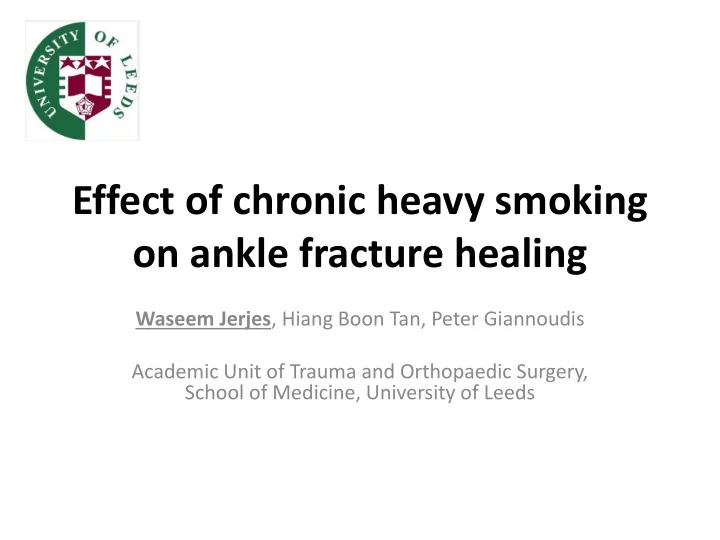

Effect of chronic heavy smoking on ankle fracture healing Waseem Jerjes , Hiang Boon Tan, Peter Giannoudis Academic Unit of Trauma and Orthopaedic Surgery, School of Medicine, University of Leeds
Cigarette smoking and bone • Osteomyelitis and delayed union/non-union in long bone fractures 1 . • Outcome of ankle fracture remains unknown. Castillo RC, Bosse MJ, MacKenzie EJ, Patterson BM; LEAP • Study Group. Impact of smoking on fracture healing and risk of complications in limb-threatening open tibia fractures. J Orthop Trauma. 2005 Mar;19(3):151-7.
Retrospective comparative study • In this study we analysed the effect of chronic heavy smoking on closed ankle fracture healing and outcomes.
Study design- prospective intent Identical treatment protocol • 173 consecutive chronic heavy smokers • Closed ankle fractures • An age and sex matched control group and Lauge- • Hansen classification system Patient demographics, co-morbidities, mechanism • of injury, and clinical details Universal advise •
Study sub-groups and outcome factors CHS with no surgical intervention (CHS-Conservative) • CHS who ultimately underwent ORIF (CHS-Surgical) • CG with no surgical intervention (C-Conservative) • CG who underwent ORIF (C-Surgical) • Primary outcome factors • - Time to fracture union - Wound healing Secondary outcome factors • - Postoperative complications - Incidence of delayed union - Non-union - Re-intervention Minimum period of follow-up was 24 months •
CHS group Control n = 173 n = 173 Gender Male 121 118 Female 52 55 Age (at time of injury) Mean 43 47 Minimum-Maximum 27-66 29-62 Standard deviation ±9.6 ±6.4 Mobility CHS Control Independent 172 173 Dependent 1 0 ADLs Independent 172 173 Dependent 1 0
CHS group Control n = 173 n = 173 Cause of injury Mechanical fall 144 162 Lauge Hansen CHS Control Sports injuries 9 2 classification Road traffic accidents 8 5 Supination-adduction 22 23 Assaults 8 3 Supination-external 103 99 Others 4 1 rotation Pronation-external 19 23 Mechanism of injury rotation Eversion 8 1 Pronation-abduction 29 28 Inversion 31 47 Dorsiflexion 59 45 Time to surgery (days) 0-8 0-9 Plantar flexion 75 80 Intervention Type of injury- closed Conservative 88 88 Uni-malleolar 42 52 External fixator 32 37 Bi-malleolar 79 68 Surgical fixation 85 85 Tri-malleolar 33 25 Fracture dislocation 19 28
CHS group Control Time to wound healing Mean (weeks) 6 2 Minimum-Maximum 4-9 1-3 Standard deviation ±2 ±1 Time to union Mean (weeks) 13 8 Minimum-Maximum 10-16 6-9 Standard deviation ±3 ±1 Follow-up Mean (months) 29.8 26.5 Minimum-Maximum 24-33 20-36 Standard deviation ±3.2 ±4.1
CHS group CHS group Control Control CHS vs. C n=173 (%) T-test n=173 (%) T-test Pearson Complications Post injury/surgery pain (4w) 38 (22.0) <.001** 4 (2.3) .045* <.001** Bleeding (oozing) (4w) 0 (0.0) - 0 (0.0) - - Swelling (4w) 18 (10.4) <.001** 2 (1.2) .158 <.001** Infection- superficial 13 (7.5) <.001** 2 (1.2) .158 <.001** Infection - deep 12 (6.9) <.001** 1 (0.6) .319 <.001** Mal union 0 (0.) - 1 (0.6) - - Delayed union 24 (13.9) <.001** 4 (2.3) .045* <.001** Non union 6 (3.5) .014 1 (0.6) .319 <.001** Neuro impairment 0 (0.0) - 0 (0.0) - - Comp. syndrome 0 (0.0) - 0 (0.0) - - LRTI 15 (8.7) <.001** 2 (1.2) .158 <.001** UTI 4 (2.3) .045* 1 (0.6) .319 <.001** DVT 2 (1.2) - 0 (0.0) - - Satisfactory RoM (4w) 152 (87.9) <.001** 169 (97.7) <.001** <.001** Mobility at last R/V Same to before injury 165 (95.4) <.001** 171 (98.8) <.001** <.001** Dependent – worse 8 (4.6) .004* 2 (1.2) .158 <.001**
CHS-Con CHS-Sur C-Con C-Sur Time to wound healing 5 7 2 2 Mean (weeks) 4-6 4-9 1-3 1-3 Minimum-Maximum ±1 ±2 ±1 ±1 Standard deviation Time to union 11 13 7 8 Mean (weeks) 10-13 10-16 6-8 7-9 Minimum-Maximum ±1 ±3 ±1 ±1 Standard deviation Follow-up Mean (months) 27.2 30.1 24.6 30.5 Minimum-Maximum 24-33 26-34 20-29 37-36 Standard deviation ±2.1 ±3.3 ±3.5 ±2.4
CHS-Con vs. C-Con CHS-Sur vs. C-Sur CHS-Con vs. CHS-Sur Postoperative complications Paired T-test Paired T-test Paired T-test Postoperative pain (4w) .004* <.001** <.001** Bleeding (oozing) (4w) - - - Swelling (4w) - <.001** <.001** Infection- superficial .158 .002* .007* Infection - deep .158 - .013* Mal union - - - Delayed union .007* <.001** .004* Non union .083 - .159 Mild neuro impairment - - - Comp. syndrome - - - LRTI .013* .007* .320 UTI .158 - .159 DVT - - - Satisfactory RoM .045* <.001** <.001** Mobility at last R/V Same to before injury .320 .024* .013* Dependent - worse .320 .024* .045*
Summary CHS surgical cohort revealed a statistically significant delay in • fracture union, when compared to conservatively managed CHS and controls. Further analysis of the CHS surgical cohort revealed a significant • correlation between smoking and postoperative duration of pain, prolonged fracture site swelling, superficial and deep wound infection, delayed union and delayed wound healing, when compared to controls. Further analysis of the conservatively managed CHS revealed a • slight increase in the incidence of post injury duration of pain, prolonged fracture site swelling and delayed union, when compared to controls.
Outcome • Chronic heavy smokers with ankle fractures requiring surgical intervention should be informed of their increased risk of delayed fracture and delayed wound healing . • Orthopaedic surgeons need to encourage their patients to enter into smoking cessation programs.
Thank you • Questions
Recommend
More recommend